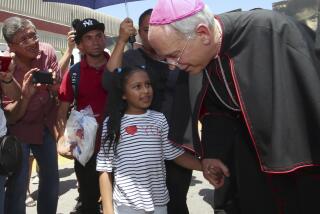Monastic Order Steps In for Dwindling Priests
- Share via
Until a few months ago, the parishioners at St. John the Baptist Church in Costa Mesa were used to seeing a lone harried cleric conducting daily Mass. The attendance of only one priest at services has become a fact of life in most Catholic parishes these days, the reality born of the dwindling of numbers to shepherd a multiplying flock.
But now, the worshippers at St. John the Baptist say they get a daily spiritual jolt at the sight of five Norbertine priests in white robes standing shoulder to shoulder at morning and evening services.
“It gives everyone a feeling that we’re all here, and we’re all together,” said Hugh Gaffney, a 15-year parishioner who attends daily Mass. “The parish priests -- they just don’t have enough of them.”
This summer, the Norbertine clerics from St. Michael’s Abbey in Silverado Canyon in south Orange County took over running the 3,000-family Costa Mesa parish and set up a mini-monastery within the church. The move was the culmination of a six-year project that trained the Norbertines to work in parishes, helping the Diocese of Orange with its shortage of priests and giving the priests from the abbey an additional line of work.
A key element of the deal was a provision for the Norbertines to continue leading a communal life, a hallmark of the order that was founded in the 12th century by St. Norbert, a German who gave up his wealth for life as a poor priest following a strict regimen of prayer and penance. Norbert started the monastic order as a reform of the lax clerical standards of his day, wanting to return priests to the practices that Augustine had developed in the 4th century. There are three other Norbertine communities in the United States and 33 in Europe.
“I think it’s reassuring to the parishioners that we’re a community functioning as one,” said Father Martin Benzoni, the parish’s new pastor. “And it’s a bright future for us. One of the responsibilities we have is showing people that it’s a good thing to have Norbertines in their parish.”
The clerics are the latest group of priests from religious orders to run one of the 55 parishes in Orange County. The Augustian Fathers, Augustinian Recollects and Servite Fathers and Brothers run a total of six parishes. And in an era when the diocese is forced to run some churches with a single priest, any new assistance is welcome.
“We could use their help,” Bishop Tod D. Brown said. “And I fully expect them to do a wonderful job.”
To create enough critical mass to develop a small but healthy monastic community at St. John the Baptist, the diocese agreed to assign four priests to the parish, one more than had previously worked there. The abbey also sent a fifth cleric, who teaches at nearby Mater Dei High School in Santa Ana, to live with his spiritual brothers.
The Norbertines, whose tradition in Europe includes work in churches, are better known in the U.S. for their teaching and rigid monastic life. Before moving into their new role, the priests spent about five years training under some of the most respected pastors in parishes throughout Orange County.
In July, the priests moved into the St. John the Baptist rectory, which they have remodeled to enhance communal living. One private study was turned into an oratory or prayer room, complete with a custom-made walnut altar. Another large room was converted into a meeting space, with a game table and chairs, couches, TV and shelves full of videos and books.
Regimented Life
Daily life for the Norbertines is much more regimented than the schedule of most parish priests, beginning with mandatory morning prayers at 5:45 a.m. The priests are also expected to attend noon and evening prayers, have dinner six nights a week in the rectory dining room and participate in a final late night prayer service before bed.
Eventually, the priests hope to add other elements of their monastic life to the parish, including their tradition of Gregorian chant.
It’s a communal life that other parish priests are trying to emulate, at least in part in response to the sexual abuse scandal that has hit their ranks. They believe isolation, usually a result of busy schedules, can lead to weakened spirituality, secret lives and no peer accountability.
“It’s a challenge to us to live more closely with each other,” said Steve Sallot, pastor of St. Edward Church in Dana Point who now organizes priestly get-togethers. “We need to be more responsible to each other and for each other.”
For many parishioners at St. John the Baptist, the Norbertines’ new assignment -- which will continue indefinitely -- means stability for a church whose former pastor was put on leave last year after the surfacing of a 21-year-old allegation of molestation.
“The place will remain intact,” Gaffney said.
Abbott Eugene Hayes, who supervises 44 priests and another 19 men in training to become priests, said he’s been pleased with the experiment so far.
“In each case with each priest we gave the diocese, I said, ‘This is a great sacrifice for us because these are valuable men,’ ” Hayes said. “But it was a sacrifice that we saw following God’s will.”
More to Read
Sign up for Essential California
The most important California stories and recommendations in your inbox every morning.
You may occasionally receive promotional content from the Los Angeles Times.













